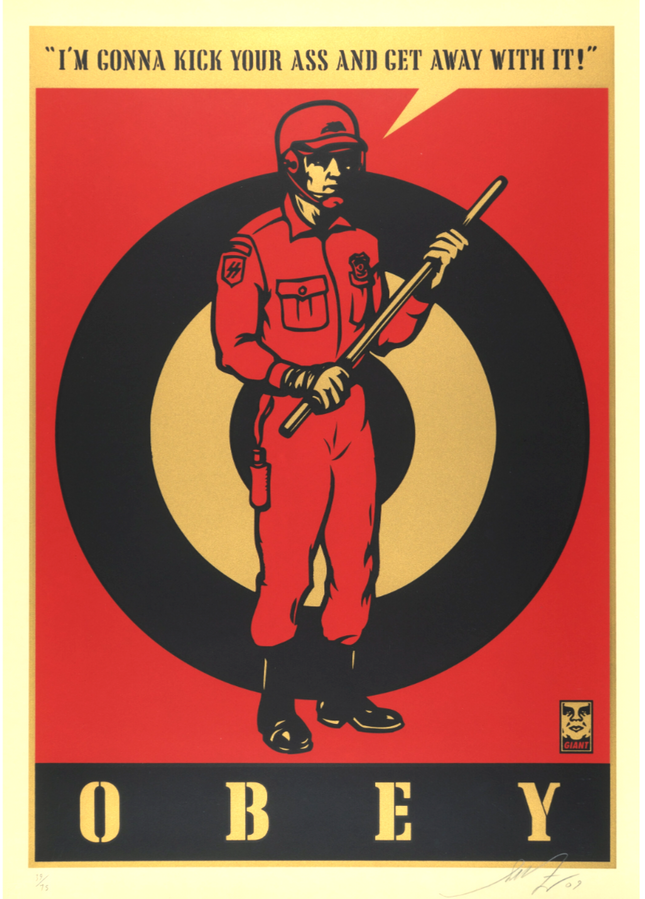
Activism

Shepard Fairey- OBEY Riot Cop Large Format Silkscreen Print by Shepard Fairey- OBEY
Riot Cop Large Format Silkscreen Print by Shepard Fairey- OBEY Hand-Pulled on Cream Speckletone Fine Art Paper Limited Edition Artwork Obey Pop Culture Artist. 2009 Signed by Shepard Fairey- OBEY & Numbered Limited Edition of 75 Large Format Artwork Size 29.25x40.5 Silkscreen Print 20 Year Retro Series. Faint Handling Creases. Shepard Fairey's OBEY: A Landmark in Street Pop Art and Graffiti Artwork Shepard Fairey's "Riot Cop" is a definitive piece that embodies the rebellious spirit and critical eye of street pop art and graffiti artwork. As part of the OBEY series, this large-format silkscreen print is more than a visual statement; it's a historical marker of the genre's evolution over two decades. Crafted with precision and care, the "Riot Cop" was hand-pulled in colors on cream Speckletone fine art paper, a medium that speaks to the quality and detail revered in fine art and the raw, unfiltered message often conveyed in street art. Released in 2009, each of the 75 editions of this large-format artwork, measuring 29.25x40.5 inches, was signed and numbered by Fairey. This gesture underscores the personal touch and authenticity valued in the world of art collectors. The artwork was reissued to mark the 20th anniversary of the OBEY project, which coincided with Shepard’s 20-year retrospective at the ICA Boston. This series, revisiting images from 1998 to 2000, showcases the artist's intention to refine previous works, substituting the iconic OBEY orange for metallic gold, lending the series an air of sophistication and timelessness. Impact and Contextual Significance of Fairey's Work The "Riot Cop" is more than an aesthetic creation; it's a commentary on authority, control, and the use of power. Fairey's work is deeply ingrained in the socio-political fabric of the times, often provoking thought on the mechanisms of society and governance. The prominent use of the word "OBEY" beneath the image of an authoritative figure wielding a baton is a direct call to the viewers to question the structures and rules that govern them. This challenge to the status quo is symbolic of the cultural force that street pop art and graffiti artwork have become, serving as an outlet for creativity and a powerful tool for social critique and activism. Shepard Fairey's journey from a skater kid with a sticker campaign to a celebrated artist with a globally recognized brand is a narrative that mirrors the ascension of street art into the mainstream consciousness. The "Riot Cop" is a testament to Fairey's growth as an artist, showcasing his skill in blending the aesthetics of street art with more profound political messages. The shift in the color palette in the anniversary series from orange to metallic gold signifies a physical transformation in the artwork. It represents a maturation of the OBEY message, which has evolved to maintain relevance in an ever-changing cultural landscape. Collectability and Legacy of the OBEY Series As a limited edition artwork, the "Riot Cop" occupies a unique space in the art market, appealing to street art enthusiasts and fine art collectors. The exclusivity of the piece and its social commentary have cemented its status as a highly desirable item. The legacy of Fairey's OBEY series is not limited to the collectors who own a piece of it; it extends to its influence on aspiring street artists and the dialogue it has inspired about the role of art in society. The series mainly works like the "Riot Cop," it continues to inspire a new generation of artists who see the urban landscape as a canvas for expressing their thoughts on contemporary issues. Shepard Fairey's "Riot Cop" from the OBEY series is a significant work that captures the essence of street pop art and graffiti artwork. It stands as a cultural artifact that encapsulates the ethos of a movement, the voice of an era, and the vision of an artist who has skillfully used silkscreen printing to challenge perceptions and invite introspection. Through his work, Fairey continues to demonstrate the power of art as a means of communication, a form of resistance, and a catalyst for change.
$7,000.00


